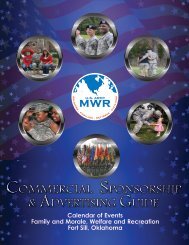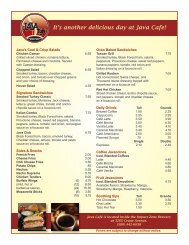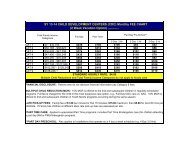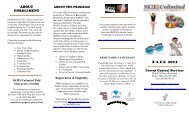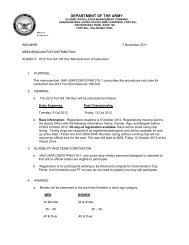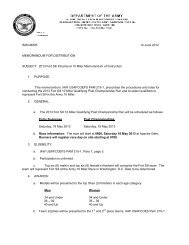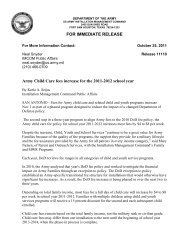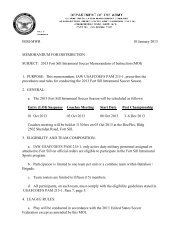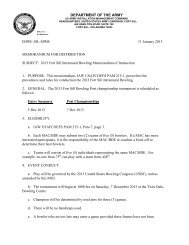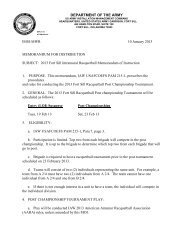Preparing and Managing Correspondence - Fort Sill MWR
Preparing and Managing Correspondence - Fort Sill MWR
Preparing and Managing Correspondence - Fort Sill MWR
You also want an ePaper? Increase the reach of your titles
YUMPU automatically turns print PDFs into web optimized ePapers that Google loves.
2–2. Use<br />
a. Formal memor<strong>and</strong>ums. The formal memor<strong>and</strong>um is used for correspondence that is sent outside the headquarters,<br />
the comm<strong>and</strong>, the installation, or similarly identifiable organizational elements within the DOD; for routine correspondence<br />
to Federal Government agencies outside the DOD; for notification of personnel actions, military or civilian; <strong>and</strong><br />
for showing appreciation or commendation to DA employees <strong>and</strong> soldiers.<br />
b. Informal memor<strong>and</strong>ums. The informal memor<strong>and</strong>um is used for internal correspondence within the same headquarters,<br />
same comm<strong>and</strong>, or similarly identifiable organizational elements. As a general rule, do not use informal<br />
memor<strong>and</strong>ums when corresponding with organizations or individuals not familiar with your office symbol. Informal<br />
memor<strong>and</strong>ums may be preprinted <strong>and</strong> used as form letters.<br />
Note. Refer to DA Memo 25–52, Staff Action Process <strong>and</strong> <strong>Correspondence</strong> Policies, for correspondence originating within the Army<br />
Staff or Secretariat Agencies.<br />
2–3. General rules<br />
a. Paper. The st<strong>and</strong>ard size is 8 1 ⁄2 by 11 inches.<br />
b. Original pages.<br />
(1) For formal memor<strong>and</strong>ums use computer-generated letterhead for the first page <strong>and</strong> plain white paper for<br />
continuing pages.<br />
(2) The informal memor<strong>and</strong>um is typed or printed on plain white paper; do not use letterhead.<br />
c. Copies. Prepare only the number of copies needed. See paragraph 1–23 for more information on record, copy<br />
furnished, <strong>and</strong> reading file copies.<br />
d. Dates. Type or stamp the day, month, <strong>and</strong> year on the memor<strong>and</strong>um flush with the right margin.<br />
e. Margins. The st<strong>and</strong>ard margin is 1 inch from the left, right, top, <strong>and</strong> bottom margins. Do not justify right margins.<br />
f. Spacing. See figures 2–1 <strong>and</strong> 2–2.<br />
g. Abbreviations <strong>and</strong> brevity codes. See paragraph 1–16.<br />
h. Acronyms. See paragraph 1–17.<br />
i. Signature blocks.<br />
(1) Type the signature block of military officials on three lines with the name (in uppercase) on the first line, rank<br />
<strong>and</strong> branch of Service on the second line, <strong>and</strong> the title on the third line. If the title requires an extra line, a fourth line is<br />
authorized. Indent the beginning of the fourth line so that the first character will be aligned underneath the third<br />
character of the third line.<br />
(2) Type the signature block of civilian officials on two lines with the name (in uppercase) on the first line <strong>and</strong> the<br />
title on the second line. If the title requires an extra line, a third line is authorized. Indent the beginning of the third line<br />
so that the first character will be aligned underneath the third character of the second line.<br />
(3) Do not use academic degrees, religious orders, or fraternal orders as part of the signature block unless it would<br />
benefit the Army for the receiver to know this information, for example, use of a medical degree to show that medical<br />
information provided was based on expertise of a member of the medical profession.<br />
(4) Do not use “(P)” (meaning that the signer is promotable) after the rank for personal benefit; use only if it would<br />
benefit the Army.<br />
2–4. Format<br />
When writing a memor<strong>and</strong>um, use the modified block style format. The format has three parts: heading, body, <strong>and</strong><br />
closing.<br />
a. Heading. The heading has five elements:<br />
(1) Office symbol. Type the office symbol on the second line below the seal. The symbol names the writer’s office<br />
(for example, DAPE–PRR). Do not use computer identification codes or word-processing codes as part of the office<br />
symbol. Other information may follow the office symbol when needed <strong>and</strong> if not part of the subject line. Some<br />
examples are the name of an individual, social security number, rank, primary military occupational specialty, contract<br />
number, or bill of lading number. Do not crowd the office or reference symbol line. If the additional information is<br />
lengthy, write it on a second line, flush with the left margin.<br />
(2) Date.<br />
(a) Put the date on the same line as the office symbol.<br />
(b) End the date approximately even with the right margin.<br />
(c) Express the date in this order: day, month, year. Day—Express in numerals. Month—Spell out if the year is not<br />
abbreviated; abbreviate if the year is abbreviated (15 January 1999 or 15 Jan 99 but not 15 January 99 or 15 Jan 1999).<br />
AR 25–50 • 3 June 2002<br />
27




